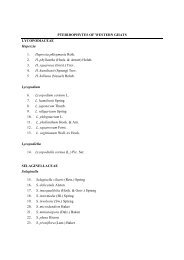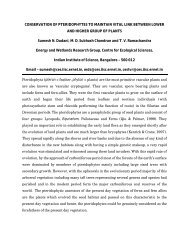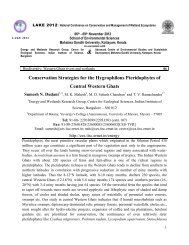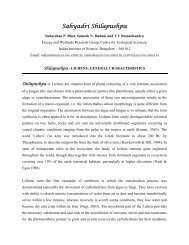regional wood energy development programme in asia ... - CES (IISc)
regional wood energy development programme in asia ... - CES (IISc)
regional wood energy development programme in asia ... - CES (IISc)
You also want an ePaper? Increase the reach of your titles
YUMPU automatically turns print PDFs into web optimized ePapers that Google loves.
Although rural <strong>in</strong> character, Hla<strong>in</strong>gdet is a prosper<strong>in</strong>g village <strong>in</strong> comparison with the other<br />
supply centres. A government owned canned fruit factory as well as an agricultural seed<br />
production centre are located near the village. Although grid electricity is available and used <strong>in</strong><br />
these two facilities, the village proper is still without electricity.<br />
4.1.2 Thahtaygon Village<br />
Thahtaygon lies 14 miles from Thazi and is also a bamboo fuel collection and trade centre.<br />
There are about 40 regular bamboo gatherers who work for the two middlemen. Besides buy<strong>in</strong>g<br />
bamboo on their own account the middlemen also supply bamboo bundles to the traders <strong>in</strong><br />
Hla<strong>in</strong>gdet for which they are paid a commission of 100-150 kyats per truck. The ma<strong>in</strong> occupation<br />
of the people is farm<strong>in</strong>g (dry cultivation). As a secondary source of <strong>in</strong>come they rely on bamboo<br />
fuel collection and quarry<strong>in</strong>g. Bamboo is collected from unclassed and reserved forests adjo<strong>in</strong><strong>in</strong>g<br />
Thazi and Pyawbwe, about 7 to 8 miles from the village. Grid electricity is available at the<br />
government owned quarry near the village of Payangasu, about one mile away from Thahtaygon.<br />
However, similar to Hla<strong>in</strong>gdet, the surround<strong>in</strong>g villages are still without electricity. Water is also <strong>in</strong><br />
short supply and villagers have to carry water from the nearby river. Thahtaygon is the poorest<br />
community among the fuel supply centres of the study area.<br />
4.1.3 Kywetatson Village<br />
Kywetatson lies 15 miles from Thazi and is the ma<strong>in</strong> charcoal and brick supply centre for<br />
the lowland pla<strong>in</strong>s. Besides fuel<strong>wood</strong> from the surround<strong>in</strong>g area a considerable amount of <strong>wood</strong><br />
is obta<strong>in</strong>ed from the Y<strong>in</strong>mab<strong>in</strong> and Yebokson areas (ma<strong>in</strong>ly for the brick kilns). The reason for this<br />
is that the permits for local <strong>wood</strong>fuel gather<strong>in</strong>g which allow only the supply of 3,000 tons of<br />
fuel<strong>wood</strong> for brick burn<strong>in</strong>g and the production of 2,500 bags of charcoal is <strong>in</strong>sufficient to meet the<br />
actual demand.<br />
4.1.4 Y<strong>in</strong>mab<strong>in</strong> Village<br />
Y<strong>in</strong>mab<strong>in</strong>, which lies at an elevation of 1,200 feet is 21 miles from Thazi. Be<strong>in</strong>g the gateway<br />
to Shan State means that both road and railway traffic make stops here. Because of this, it has<br />
also become a trad<strong>in</strong>g centre. There is a hospital, a high school and a police station but it is still<br />
treated as a village by the adm<strong>in</strong>istrative sector. Water is scarce and there is no grid electricity. It<br />
is surrounded by forests and as it has three sawmills, which supply mill off-cuts and sawdust to<br />
Thazi, Meiktila and Yenanchaung, it has become the major supply po<strong>in</strong>t for fuel<strong>wood</strong> to the dry<br />
zone. Most of the people employed as fuel<strong>wood</strong> gatherers come from the nearby Monp<strong>in</strong>son and<br />
Madan villages.<br />
4.1.5 Yebokson Village<br />
Yebokson (which lies about 25 miles from Thazi) and the surround<strong>in</strong>g villages of Kuby<strong>in</strong>,<br />
Monp<strong>in</strong> and Oakky<strong>in</strong> were founded by the Forest Department. This was done <strong>in</strong> order to have<br />
sufficient labour dur<strong>in</strong>g the seasonal forest operations such as tree girdl<strong>in</strong>g, fell<strong>in</strong>g and plantation<br />
establishment. Both <strong>wood</strong> and bamboo are supplied with most <strong>wood</strong>fuel gatherers recruited from<br />
Yebokson and the nearby villages. Yebokson and Kuby<strong>in</strong> reserves are the ma<strong>in</strong> supply sources<br />
but only dry <strong>wood</strong> from dead and dy<strong>in</strong>g trees is allowed to be taken from the Kuby<strong>in</strong> reserve. The<br />
source is about 6-7 miles away from the village.<br />
13














